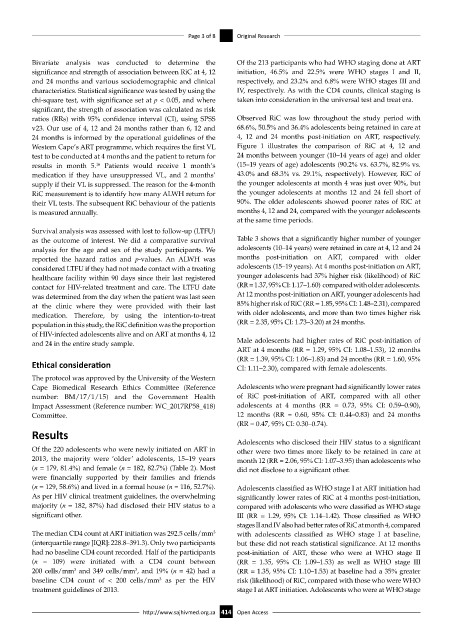Page 422 - HIVMED_v21_i1.indb
P. 422
Page 3 of 8 Original Research
Bivariate analysis was conducted to determine the Of the 213 participants who had WHO staging done at ART
significance and strength of association between RiC at 4, 12 initiation, 46.5% and 22.5% were WHO stages I and II,
and 24 months and various sociodemographic and clinical respectively, and 23.2% and 6.8% were WHO stages III and
characteristics. Statistical significance was tested by using the IV, respectively. As with the CD4 counts, clinical staging is
chi-square test, with significance set at p < 0.05, and where taken into consideration in the universal test and treat era.
significant, the strength of association was calculated as risk
ratios (RRs) with 95% confidence interval (CI), using SPSS Observed RiC was low throughout the study period with
v23. Our use of 4, 12 and 24 months rather than 6, 12 and 68.6%, 50.5% and 36.4% adolescents being retained in care at
24 months is informed by the operational guidelines of the 4, 12 and 24 months post-initiation on ART, respectively.
Western Cape’s ART programme, which requires the first VL Figure 1 illustrates the comparison of RiC at 4, 12 and
test to be conducted at 4 months and the patient to return for 24 months between younger (10–14 years of age) and older
results in month 5. Patients would receive 1 month’s (15–19 years of age) adolescents (90.2% vs. 63.7%, 82.9% vs.
16
medication if they have unsuppressed VL, and 2 months’ 43.0% and 68.3% vs. 29.1%, respectively). However, RiC of
supply if their VL is suppressed. The reason for the 4-month the younger adolescents at month 4 was just over 90%, but
RiC measurement is to identify how many ALWH return for the younger adolescents at months 12 and 24 fell short of
their VL tests. The subsequent RiC behaviour of the patients 90%. The older adolescents showed poorer rates of RiC at
is measured annually. months 4, 12 and 24, compared with the younger adolescents
at the same time periods.
Survival analysis was assessed with lost to follow-up (LTFU)
as the outcome of interest. We did a comparative survival Table 3 shows that a significantly higher number of younger
analysis for the age and sex of the study participants. We adolescents (10–14 years) were retained in care at 4, 12 and 24
reported the hazard ratios and p-values. An ALWH was months post-initiation on ART, compared with older
considered LTFU if they had not made contact with a treating adolescents (15–19 years). At 4 months post-initiation on ART,
healthcare facility within 90 days since their last registered younger adolescents had 37% higher risk (likelihood) of RiC
contact for HIV-related treatment and care. The LTFU date (RR = 1.37, 95% CI: 1.17–1.60) compared with older adolescents.
was determined from the day when the patient was last seen At 12 months post-initiation on ART, younger adolescents had
at the clinic where they were provided with their last 85% higher risk of RiC (RR = 1.85, 95% CI: 1.48–2.31), compared
medication. Therefore, by using the intention-to-treat with older adolescents, and more than two times higher risk
population in this study, the RiC definition was the proportion (RR = 2.35, 95% CI: 1.73–3.20) at 24 months.
of HIV-infected adolescents alive and on ART at months 4, 12
and 24 in the entire study sample. Male adolescents had higher rates of RiC post-initiation of
ART at 4 months (RR = 1.29, 95% CI: 1.08–1.53), 12 months
(RR = 1.39, 95% CI: 1.06–1.83) and 24 months (RR = 1.60, 95%
Ethical consideration CI: 1.11–2.30), compared with female adolescents.
The protocol was approved by the University of the Western
Cape Biomedical Research Ethics Committee (Reference Adolescents who were pregnant had significantly lower rates
number: BM/17/1/15) and the Government Health of RiC post-initiation of ART, compared with all other
Impact Assessment (Reference number: WC_2017RP58_418) adolescents at 4 months (RR = 0.73, 95% CI: 0.59–0.90),
Committee. 12 months (RR = 0.60, 95% CI: 0.44–0.83) and 24 months
(RR = 0.47, 95% CI: 0.30–0.74).
Results
Adolescents who disclosed their HIV status to a significant
Of the 220 adolescents who were newly initiated on ART in other were two times more likely to be retained in care at
2013, the majority were ‘older’ adolescents, 15–19 years month 12 (RR = 2.06, 95% CI: 1.07–3.95) than adolescents who
(n = 179, 81.4%) and female (n = 182, 82.7%) (Table 2). Most did not disclose to a significant other.
were financially supported by their families and friends
(n = 129, 58.6%) and lived in a formal house (n = 116, 52.7%). Adolescents classified as WHO stage I at ART initiation had
As per HIV clinical treatment guidelines, the overwhelming significantly lower rates of RiC at 4 months post-initiation,
majority (n = 182, 87%) had disclosed their HIV status to a compared with adolescents who were classified as WHO stage
significant other. III (RR = 1.29, 95% CI: 1.14–1.42). Those classified as WHO
stages II and IV also had better rates of RiC at month 4, compared
The median CD4 count at ART initiation was 292.5 cells/mm with adolescents classified as WHO stage I at baseline,
3
(interquartile range [IQR]: 228.8–391.3). Only two participants but these did not reach statistical significance. At 12 months
had no baseline CD4 count recorded. Half of the participants post-initiation of ART, those who were at WHO stage II
(n = 109) were initiated with a CD4 count between (RR = 1.35, 95% CI: 1.09–1.53) as well as WHO stage III
200 cells/mm and 349 cells/mm , and 19% (n = 42) had a (RR = 1.35, 95% CI: 1.10–1.53) at baseline had a 35% greater
3
3
baseline CD4 count of < 200 cells/mm as per the HIV risk (likelihood) of RiC, compared with those who were WHO
3
treatment guidelines of 2013. stage I at ART initiation. Adolescents who were at WHO stage
http://www.sajhivmed.org.za 414 Open Access

